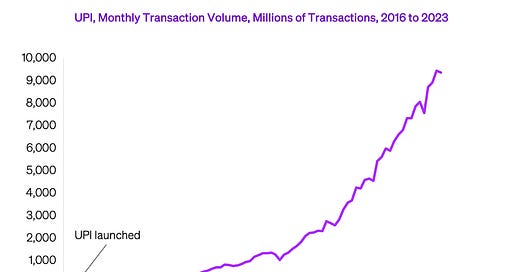Deep Dive: Is India the Next Economic Giant?
Where is India’s economy today and where might it be tomorrow? From demographics to geopolitics, what are the key factors that will shape India’s economic future?
Around 20 years ago, China experienced a period of unprecedented economic growth and technological advancement. I watched many of my friends invest early in China and achieve remarkable success.
Yet, I didn't make a single investment then. Why?
I didn't feel like I understood China. I couldn't speak the language, I didn't grasp the political landscape, and I felt like an outsider looking in.
When I look at India, I feel entirely different about it. India's democratic ideals align well with those of the United States. Many Indians speak English, which removes the language barrier, and there are favorable conditions for American entrepreneurs and investors to create successful businesses.
Around 2016, when India launched UPI (digital payment system), a few of my friends and I made some bets then. Even though UPI was a huge success, in hindsight, 2016 was too early to invest in India and my bets didn’t pay off. Even though we saw a wave of successful startups like Flipkart and Zomato emerge during that time, in many ways, India's startup ecosystem was still nascent.
Today, India feels very different from how it was in 2016. Even though some of the same fundamental characteristics remain (e.g., the world's largest working-age population, many talented and educated individuals), the tectonic plates of India's economy have shifted significantly in the past eight years, and many of the long-standing obstacles that were holding back India's economic growth have been addressed.
All this to say, through my own experience of investing in India, I realized that focusing on narrow aspects (e.g., momentum of investment in Indian startups) is necessary but insufficient. It is understanding how the structural pieces of India’s economy fit together that offers the clearest understanding of where India’s economy is today and if it’s the next economic giant.
Many articles have been written about India’s economic potential, but every article I came across, I felt that it was missing this foundational and multi-dimensional approach.
This deep dive builds a foundational understanding of India, from the lens of its economic potential. We will discuss India’s history, governance, demographic profile, technology sector, financial sector, infrastructure, and geopolitical position, to help you understand where India is in its economic development.
We assume the reader has no prior knowledge of India. One of our goals for this deep dive is to come at the subject with the right entry point, so you can develop an enduring perspective that you can build upon over time. If you don’t know very much about India, one sign we’ve done our job is that if, after reading this deep dive, the subject of India should feel less impenetrable (like China was for me), so you have the right footing to read news about India, meaningfully participate in discussions about India, and form a nuanced worldview.
Later, we will do more deep dives on India that branch out and dive into specific topics, with this one as the base.
One thing I want to say is that my team and I spend a lot of time and energy to create an enjoyable reading experience. Our deep dives are designed to be read in one go, like a flip book. If we’ve done our job well, after 20-30 minutes of reading, you should be able to form a clear picture of where India stands in terms of its economic potential. We’ve also included a companion podcast, which we think introduces the deep dive pretty well.
Part of what makes working on these deep dives so enjoyable is the people we work with to bring them to life. I would especially like to thank Sharvi Dubey (LinkedIn) and Rohan Malhotra (X) at Good Capital for their contributions to this work.
I hope you enjoy reading, and let me know what you think.
By the way, we plan to post our next two deep dives on Federal Agencies and Elections later this month.
Chamath




